
437
.pdfМИНИСТЕРСТВО ВНУТРЕННИХ ДЕЛ РОССИЙСКОЙ ФЕДЕРАЦИИ
ФЕДЕРАЛЬНОЕ ГОСУДАРСТВЕННОЕ КАЗЕННОЕ ОБРАЗОВАТЕЛЬНОЕ УЧРЕЖДЕНИЕ ВЫСШЕГО ПРОФЕССИОНАЛЬНОГО ОБРАЗОВАНИЯ
«МОСКОВСКИЙ УНИВЕРСИТЕТ МВД РОССИИ
ИМЕНИ В.Я. КИКОТЯ»
Кафедра иностранных языков.
О.Ю. Гольцева
ГЛОССАРИЙ
по судебной баллистике
Под редакцией к.ю.н., профессора,
Заслуженного работника Высшей школы И.А.Горшеневой
Утвержден на заседании 25 апреля, протокол № 8
Москва 2019
Пояснительная записка.
Данный глоссарий является приложением к учебному пособию по судебной баллистике и направлен на реализацию государственной стратегии в области иноязычного образования на основе проектирования определенных аспектов профессиональной деятельности сотрудников внутренних дел по вопросам судебнобаллистической экспертизы и организацию образовательного процесса на основе формирования элементов иноязычной профессиональной компетенции для обучающихся по специальности: 40.05.03 Судебная экспертиза (специализация – криминалистические экспертизы) в рамках совместного проекта Управления учебно-методической работы , кафедры оружиеведения и трасологии и кафедры иностранных языков Московского университета МВД России имени В.Я. Кикотя .
Глоссарий предназначен для проведения аудиторных занятий по дисциплине «Иностранный язык», а также специальным дисциплинам для обучающихся на факультетах подготовки иностранных специалистов и повышения квалификации.
Цель глоссария - совершенствование иноязычной компетенции обучающегося контингента на основе развития коммуникативных навыков в ходе осуществления профессиональной деятельности по специализации – криминалистические экспертизы, включая теоретические и методические основы судебно-баллистических исследований стрелкового огнестрельного оружия и следов его применения. Терминология глоссария призвана способствовать формированию навыков аналитического чтения профессионально ориентированных учебных материалов, умений извлекать необходимую информацию и критически ее осмысливать.
Глоссарий состоит из 3 частей ( глоссария, раскрывающего содержание профессиональных терминов в области конструкции стрелкового огнестрельного оружия и боеприпасов к нему на английском языке, русско - английского толкового словаря и англорусского словаря), направленных на формирование у обучающихся межкультурной профессионально ориентированной коммуникативной компетенции, позволяющей использовать полученные иноязычные навыки как в практике профессиональной деятельности, так и в целях дальнейшего самообразования.
Материалы представленного глоссария по судебной баллистике также предоставляют возможность разработки индивидуальных учебных стратегий для каждого.
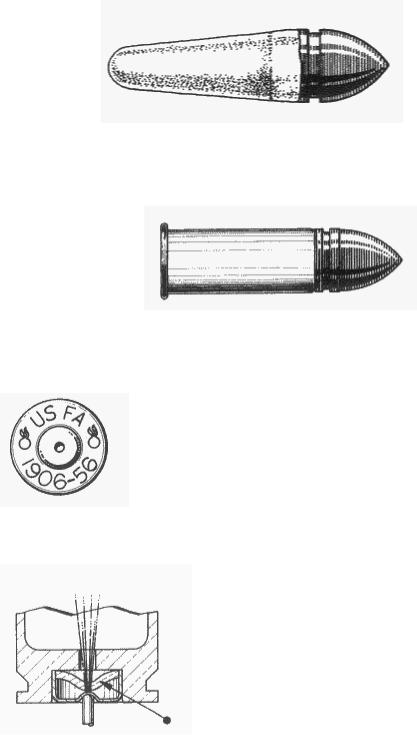
PART 1
GUT CARTRIDGE - A primitive combustible cartridge consisting of a tubular sheath or sack filled with black powder which is attached to the base of a conical bullet. The sheath is made from thin, treated animal gut and is reasonably moisture proof. See William Mont Storm patent #33,611 and Hotchkiss patent #34,364. Most were made by D.C.Sage and found in .36, .44, and .56 Colt caliber as well as
a few others.
ALLEN, ETHAN - A gunmaker in the mid1800s who produced a distinctive series of cartridges along with his guns. A series of rimfires from .22 short to .5656 Spencer were made. Most are readily identified by the distinctive bullet design.
See also LIPFIRE.
ANNIVERSARY ROUND - A special commemorative cartridge, usually with a special headstamp which is issued to mark a particular event. A popular example is the .30-06 round issued to mark the 50th anniversary of that cartridge.
ANVIL - A portion of the primer pocket or primer which provides resistance to the crushing action of the firing pin which causes the printing mixture to detonate.
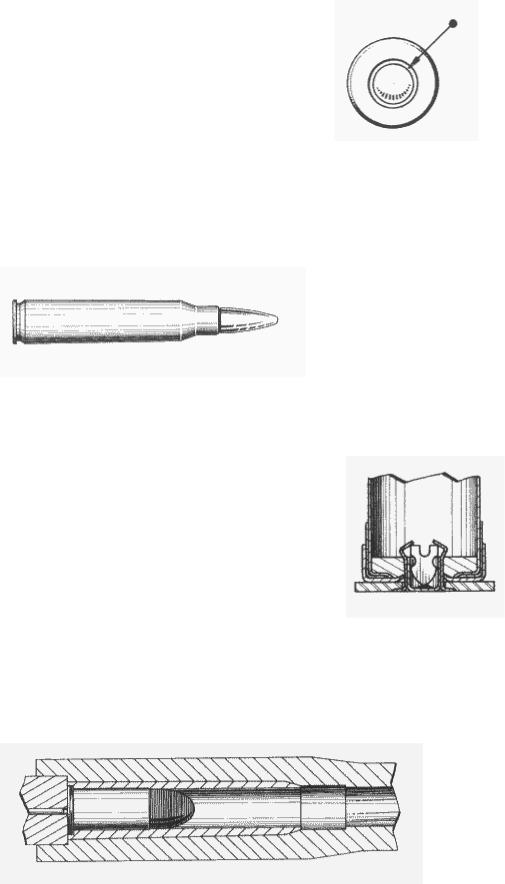
ANNULAR RING - A circumferential crimp or indentation around the primer. In some military rounds, a dye was used in this ring for waterproofing and often to
identify some characteristic of the cartridge.
ASSAULT RIFLE CARTRIDGE - Any one of a growing family of smallcaliber, short-case-length cartridges which are designed for modern high rate-of- fire assault weapons. These were developed to reduce recoil, to make automatic fire more controlled and to enable personnel to carry more ammunition to support the high rate of consumption with those weapons.
ATTACHED HEAD - Relatively early centerfire cartridges which were designed to have the head of the cartridge attached to the body by riveting or other means. Rounds of this design can be attributed to the late 1860s and several decades
beyond. A typical example is the .577 Snider.
AUXILIARY CARTRIDGE or CHAMBER - An adaptive device which may superficially resemble a cartridge but which, in reality, is a "chamber space filler" enabling a smaller round to be used in a gun chambered for a larger cartridge. Thus a .32 short centerfire pistol cartridge can be fired in a WWII German Mauser which normally would chamber a 7.92 x 57 round.
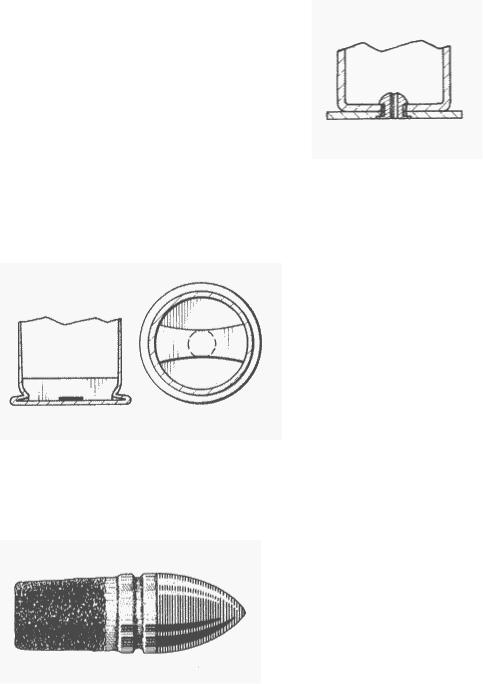
BALL ROUND - Originally referring to round balls as opposed to shot or shell in early muskets or artillery. Now used in military parlance to denote the basic nonspecialized bullet type, as opposed to armor-piercing, tracer, etc.
BALLOON RIVET - A large hemispherical-headed rivet sometimes used to secure an attached head to a cartridge case. The head of the rivet is visible when looking into the mouth of an empty case having this feature. Usually ap-plied to
thin-rim Maynard separate-primed cases.
BAR ANVIL-PRIMED – An early type of inside-primed cartridge (patented by E.H.Martin, evolved from #48,820, 7-1-1865) in which a short bar of iron is transverse to the base of the cartridge and secured by distinctive crimps. This bar serves as an anvil, against which the firing pin can impact to cause ignition.
BARTHOLOW PATENT - An early combustible cartridge (patent #32,345. 5- 21-1861) in which the powder was compressed and semi-solidified, and adhered to the base of the bullet. There is a visible outer linen wrap to assist in holding the powder to the bullet firmly and to provide moisture protection.
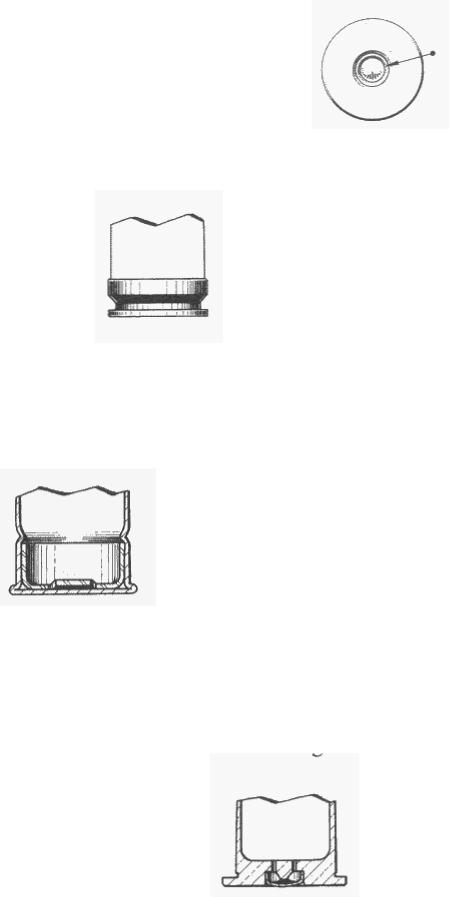
BATTERY CUP - A flanged metallic cup used in shotshell primer assemblies that
provides a rigid support for the primer cup and anvil.
BELTED CASE - A case with a distinct raised ring around the head just forward of the extractor groove, used to headspace the cartridge. Found on many high
velocity rifle cartridges.
BENET-PRIMED - A common style of inside-primed car-tridge developed by Col. S.V Benet commander of Frankford Arsenal in the late 1860s. It was used extensively in early U.S. military ammunition. A copper or iron cup was secured inside the head of the case by characteristic crimps. This cup served as an anvil to enable the firing pin to activate the priming mixture and also to reinforce the head
of the case.
BERDAN-PRIMED - A centerfire cartridge design by Hiram Berdan (patent #82,587, 9-29-1868). A primer consisting of a metal cup filled with priming mixture and sealed with foil or shellac was inserted into the primer pocket of the cartridge case. The anvil is part of the cartridge case, i.e. a raised portion of the primer pocket which was perforated to permit the ignition to set off the powder charge. Starting in the early 1870s this type of printing system was widely used for
both military and sporting ammunition.
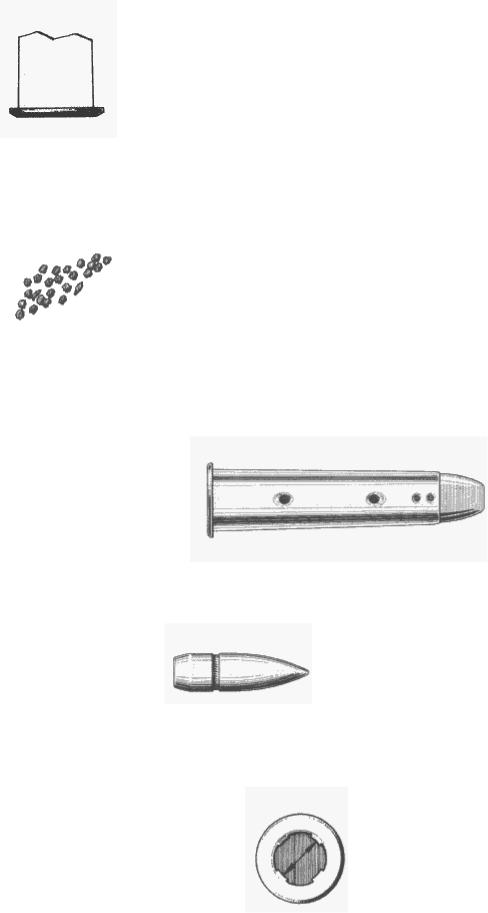
BEVELED HEAD - Describes a style of cartridge case in which a bevel is machined or formed around the outer portion of the rim of the cartridge case.
BLACK POWDER - The first type of gunpowder consisting of a mixture of charcoal, sulfur and potassium nitrate. It is characteristically graded by grain size such as Fg (coarse) or FFFFG (fine). It generates low pressures in gun chambers.
BOARD DUMMY - Usually an inert specimen cartridge which was prepared by the factory for mounting on a promotional or educational display board. These usually have holes drilled or punched through case walls for mounting wires and often have wooden rods internally. Original specimens usually bring a premium
over regular equivalents.
BOAT-TAILED BULLET - A bullet whose base is tapered similar in profile to a boat's stern. The purpose is to reduce ballistic drag. This has also been referred to
as a taper-heel bullet.
BORE - The bore diameter of a weapon. For rifled weapons it is usually the land or minimum diameter. This is expressed in either inches or millimeters. Some early rifled weapons and both early and present shotguns bores use the "GAUGE"
terminology, defined elsewhere.
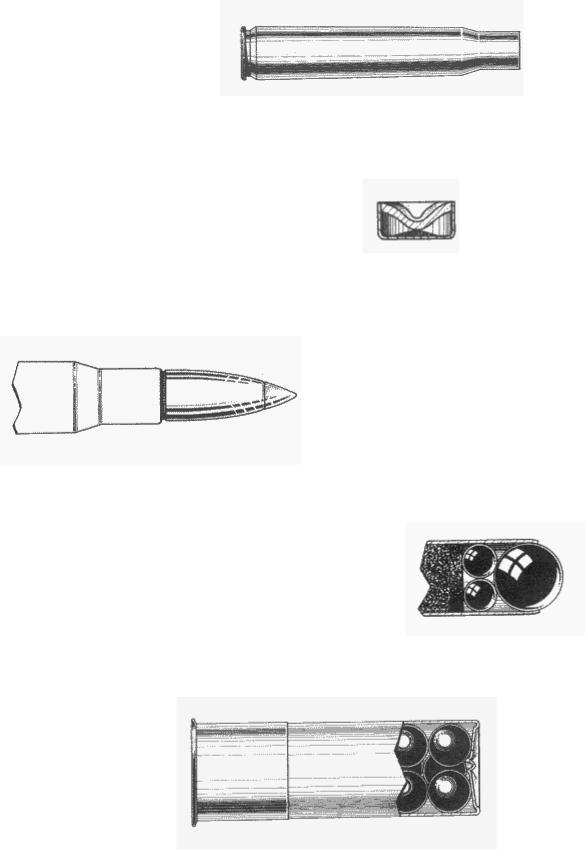
BOTTLENECKED CASE - A cartridge case having abrupt reduction in its diameter toward its open or mouth end. This permits large case capacity without
making the case overly long.
BOXER PRIMER - A priming system developed in the late 1860s by Col. E.M. Boxer of England. (U.S. Patent #91,81 of 6-29-1889) as an improvement to Daw's Patent. The primer contained both the priming mixture and an anvil. This system is
used in most modern U.S. centerfire cartridges.
BRONZE POINT (BULLET) - A separate bronze wedge was fitted to the point of the bullet of various big-game cartridges. It provided both aerodynamic streamlining and served to initiate expansion on impact.
BUCK AND BALL - A loading wherein a combination of a single ball and several smaller balls were loaded into a single cartridge to improve firepower. In
larger calibers, sometimes called CANISTER rounds.
BUCKSHOT - Generally any cartridge loaded with a number of large round balls. Originally the term related to deer hunting. The term has been applied to both old
and modern cartridges.
CANNELURE(S) - The circumferential swaged, machined or milled groove(s) around a bullet (for sealing; also often for identification) or cartridge case. Often
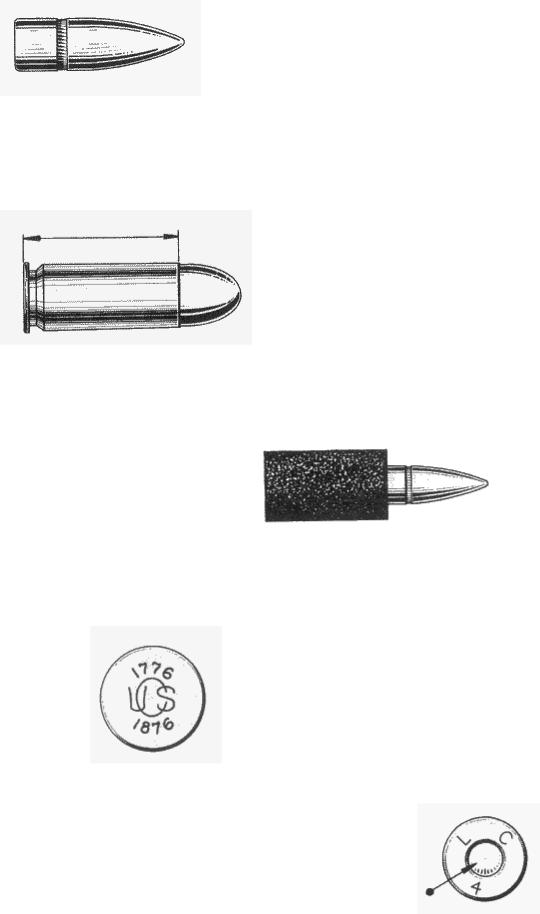
used to provide visual or tactile identification of special loadings of military ammunition. They are also used to hold lead bullet lubricant.
CARTOUCHE - The French language equivalent of the word "cartridge" but also meaning "box" or enclosure, such as an "inspector's cartouche" referring to the boxed inspectors stamp appearing on some guns and headstamps.
CASE LENGTH - The longest measurement of a cartridge case.
CASELESS CARTRIDGE - Usually refers to relatively modern cartridges wherein the "case" is molded solid propellant with an attached projectile and primer. The "case" is consumed in firing. These are basically experimental types
designed to save weight and cost.
CENTENNIAL ROUND - A special-headstamped commemorative cartridge referring to special .45-70 cases and rounds made up at the U.S. Centennial Exposition in 1876. Headstamp is an entwined USC (U.S. Carbine) with the dates
1776-1876.
CENTERFIRE - A cartridge case whose peimer is located at the geometric center
of its circular base. Such rounds are usually reloadable.
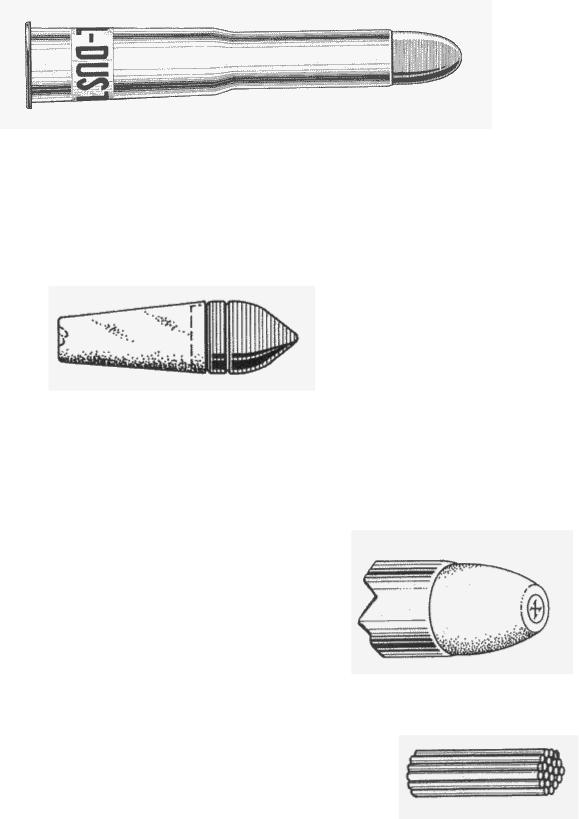
COAL-DUST DUMMY - A type of inert cartridge made in Britain in which coal dust has been substituted for gun powder to approximate the weight and feel of a loaded round. These are highly collectable and usually have an affixed paper label reading "COAL-DUST.”
COLLODION - A cellulose treatment applied to certain 1850-60-period combustible cartridges to help render them moisture-resistant (see Bartholow's and Hazard's Patents)
COMBUSTIBLE CARTRIDGE - A term applied to certain early ammunition which contained propellant in a sometimes nitrated paper casing which was affixed to or enclosed the projectile. The entire envelope was consumed in the firing of the
round
COPPER WASH -A copper coating which was applied to a steel cartridge case for the purpose of corrosion resistance.
COPPER-TUBED BULLET - A lead hollow-pointed bullet into which is inserted a thin, closed-ended copper tube. Its purpose was to preserve the bullet's aerodynamic shape. Sometimes the tube was charged with fulminate to create an
explosive bullet. Also called "Express Bullet".
CORDITE - A type of smokeless nitrocellulose powder which was used widely in British military and sporting cartridges. Cordite grains usually resemble very thin
strands of spaghetti but sometimes have other forms.
CORRUGATED CASE - Cartridges whose cases have been subjected to dies which form deep, usually longitudinal grooves in the case. These provide both
